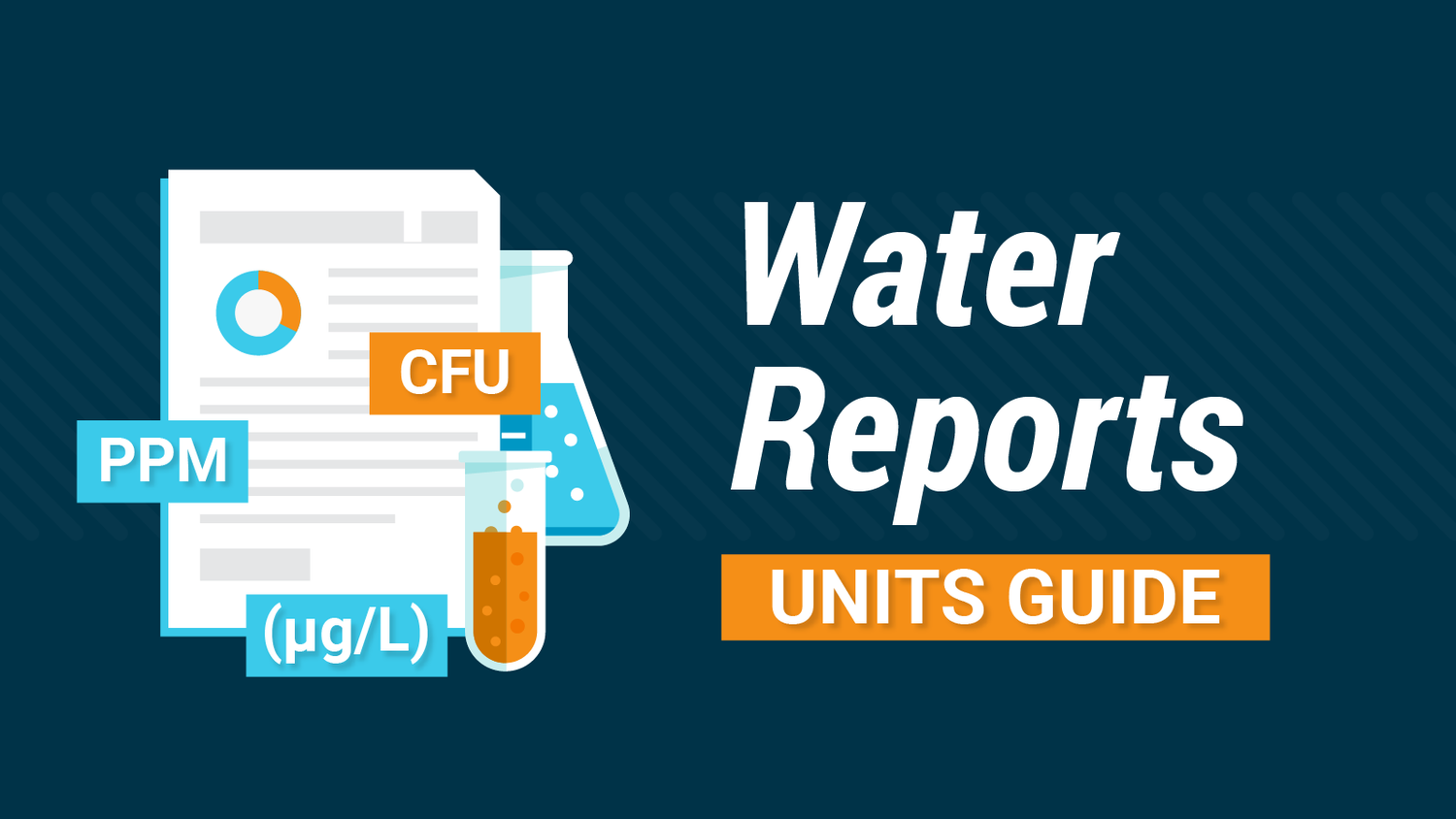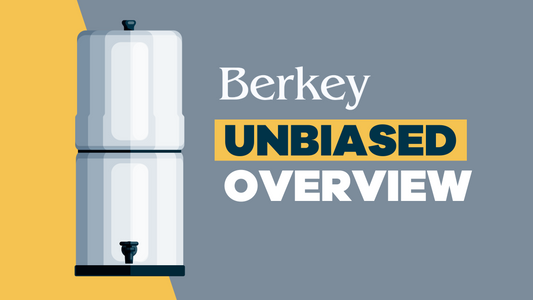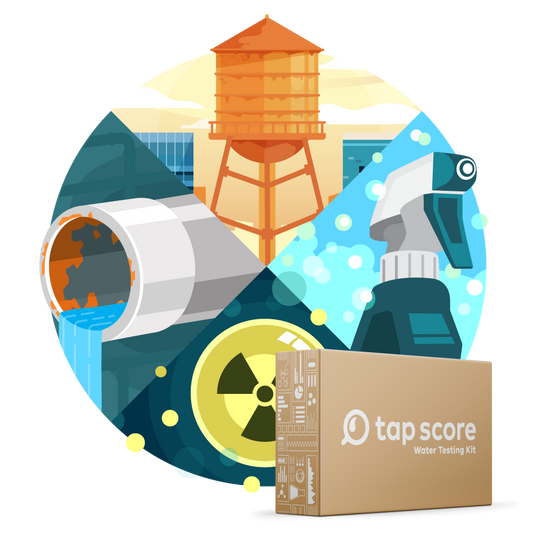
How To Interpret Water Testing Units
Our blog is written by real experts— not AI. Each guide is carefully reviewed and updated based on the latest research. Plus, with no affiliate links, you can count on unbiased insights you can trust.
Water contaminants are measured using a variety of units depending on what fits best. Some units can readily convert between one another (like PPM, PPB, and PPT), others are entirely unrelated.
In this article, we will explain how to interpret units for measuring chemical, biological, radiological, and unit-less contaminants that you often encounter on your water quality reports.
Chemical Contaminants
PPM
PPB and PPT
Biological Contaminants
CFU/mL
P/A test
Radiological Contaminants
pCi/L
Units for Chemical Contaminants
The best way to quantify chemical contaminants in water is through their concentrations.
Concentrations describe the mass amount of a particular contaminant per a volume amount of water and are represented (fittingly) by concentration units.
Concentration units make up the majority of units on water testing reports and describe contaminants such as:
- Metals
- Ions
- Minerals
- Synthetic Chemicals
The first unit we will explore is actually a pseudo-unit! Part per notation is one of the most common concentration units used in water testing. This notation describes how many “parts” of a contaminant exist per the number of “parts” of water, like a ratio. For example, you could have 40 parts of elemental magnesium in 1 million parts of water, or 40 parts per million.
One reason why parts per notation can be so confusing is because it is not actually a unit of measurement–like mg/L or μg/L. Parts per notation is actually a pseudo-unit because it has no predefined dimension (like length, volume, or mass).
The most common parts-per units are parts per million (PPM), parts per billion (PPB), and parts per trillion (PPT). These parts are either mass (e.g. mg of contaminant per gram of water) or volume based (e.g., mg of contaminant per liter of water). In water testing, it is almost always safe to assume parts-per notation represents a mass per volume value.
What Does PPM Mean?
The parts per million (PPM) unit equals the number of parts of a contaminant per million parts of water volume. PPM is seen very regularly on water test reports.
If the scale of PPM is difficult to conceptualize, try imagining: one minute in the span of two years equals around 1 PPM.
When volume-based, 1 PPM equals 1 mg/L. PPM can also easily convert to parts per billion (PPB) and parts per trillion (PPT), other important units that quantify contaminants in water.
What Do PPB and PPT Mean?
PPB and PPT notation represents the number of parts of a contaminant per billion parts water and trillion parts water, respectively. If you ever find yourself looking at a “grams-per-liter” notation, just remember 1 µg/L equals 1 PPB and 1 ng/L equals 1 PPT.
To put PPB and PPT into perspective:
The area of a standard sheet of paper compared to the area of West Virginia represents about 1 PPB.
One water droplet in 20 Olympic swimming pools is roughly the equivalent of 1 PPT.
Arsenic and lead concentrations are almost always written using PPB. For example, EPA’s Maximum Contaminant Level (MCL) for arsenic is 10 PPB (or 10 µg/L).
PPT is used for contaminants detected at extremely low levels. PPT is seen far less on water testing reports than PPM or PPB. This is either because instrumentation that tests water samples cannot detect levels that low or the water contaminant exists at much higher concentrations such that PPM and PPB are more appropriate units of measurement.

Units for Biological Contaminants
Although they are frequently and effectively used in water testing reports, parts-per notation cannot quantify all water contaminants. For example, biological contaminants require a totally different way to describe their presence. Such biological contaminants include:
- Bacteria (E. coli, Coliform, Legionella, etc.)
- Protozoa (Giardia, Cryptosporidium, etc.)
- Algae
- Molds and Fungus
“Colony formation units” per volume of water unit (represented as CFU/mL or CFU/100 mL depending on the dilution of the sample) frequently quantifies a range of biological contaminants.
What Is a CFU/mL?
A “colony formation unit” per milliliter (CFU/mL) represents the number of living cells in one milliliter of sample. CFU/mL is used specifically for measuring biological contaminants like molds, fungus, and some bacteria.
To measure CFUs, cells from a sample of water are first cultured, or grown in controlled environments suitable for the specific cells. Then, the resulting cell colonies, or clusters of cells that come from the same parent cell, are counted per volume of sample added.
When the biological contaminant in question is considered harmful at any concentration, a CFU/mL measurement is unnecessary. Instead, a presence/absence test is all that’s needed.

What Is a Presence/Absence Test?
A presence/absence (P/A) test indicates whether or not a specific biological contaminant exists in your water sample. There are no units associated with a P/A test because it does not quantify the concentration of bacteria.
Many regulatory bodies like the EPA use P/A tests because they are generally more accurate, low cost, and fast.
P/A tests are used for Total Coliform and E. coli because their presence (at any concentration) could indicate the presence of other harmful pathogens. The US EPA Maximum Contaminant Level (MCL) for both Total Coliform and E. coli is zero, meaning any presence exceeds the legal limit and is considered a concern.
Units for Radiological Contamination
Radiological units are used for measuring contaminants such as:
- Gross Alpha Radiation
- Gross Beta Radiation
- Radon
- Radium-226/228
- Strontium
One of the most common radiological units seen on water testing reports, picocuries per liter (pCi/L) describes the radioactivity emitted per volume of water.
One “picocurie” equals to a trillionth of a “curie” (named after scientists Marie and Pierre Curie who were well-known for studying radiation). A curie is defined as the amount of radioactivity emitted by 1 gram of radium.
In the United States, the standard unit for radioactivity is pCi/L. Wherever the metric system is used (i.e. virtually everywhere else), the becquerels per cubic meter (Bq/m3) is the accepted unit of measurement. One pCi/L is equivalent to 37 Bq/m3.

Why Are Some Water Testing Results Unit-less?
Some physical water parameters like pH, Sodium Absorption Ratio (SAR), and Langelier Saturation Index (LSI) don’t need units. Instead, these values are understood as a point on a scale.
For example, pH describes the acidity or basicity of water on a logarithmic scale–0 meaning extremely acidic, 14 meaning extremely basic, and 7 meaning neutral. So if your water’s pH is 8, then it is considered slightly basic with respect to this scale.
What's the Takeaway?
Getting your water properly tested with a lab testing kit should include a wide variety of water contaminants. For example, Tap Score’s Essential Well Water Test analyzes a wide range of factors including, pH, alkalinity, metals (like arsenic and lead and nickel), coliform bacteria, and other parameters. Such a test will inherently include a wide variety of units. All these units and their implicit meaning might seem difficult to understand at first, but hopefully your Report and this Tips for Taps article make it more clear.
If you have any additional questions or need more explanation on some units that are tripping you up, don’t hesitate to reach out to our expert water chemists, scientists, and engineers at support@mytapscore.com.
Sources and References
▾Dimensions, Units, Conversion Factors, and Significant Digits
Coliform Bacteria and Drinking Water
Marie and Pierre Curie and the discovery of polonium and radium
Your Water’s General Chemistry
Sodium Adsorption Ratio, Irrigation, and Soil Health | SimpleLab Tap Score










